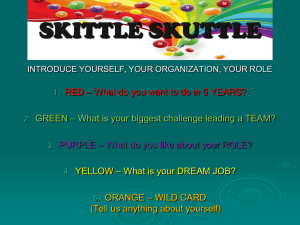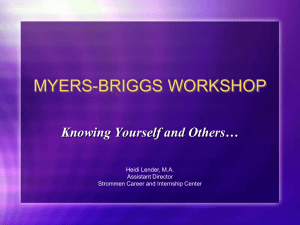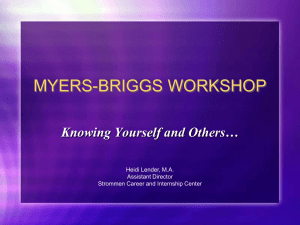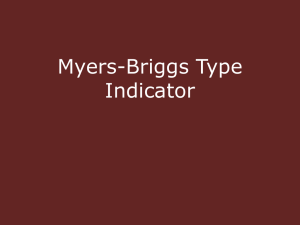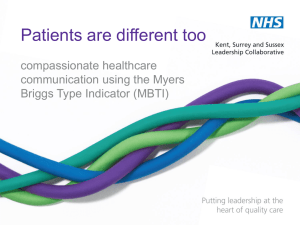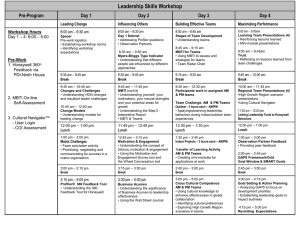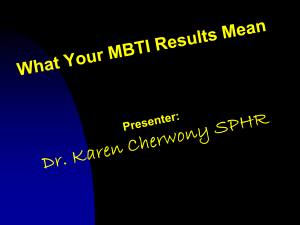Personality - WordPress.com
advertisement
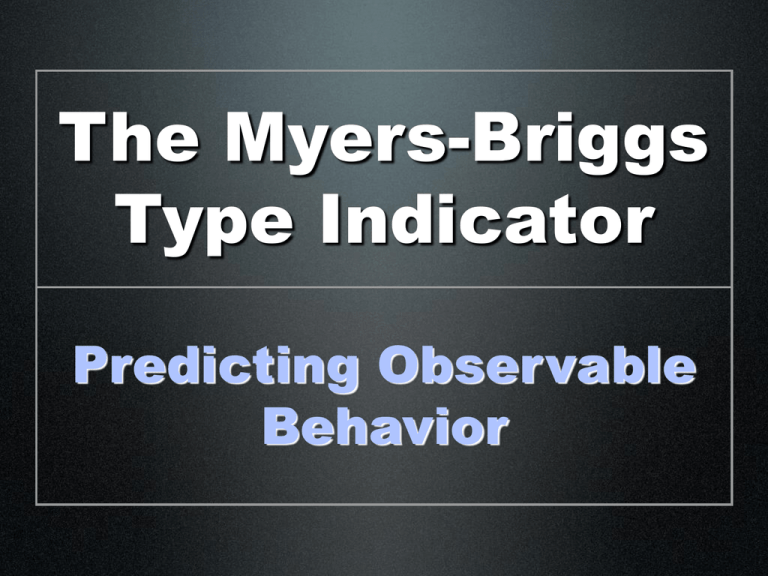
The Myers-Briggs Type Indicator Predicting Observable Behavior Class Writing Activity • MBTI = preference • We can operate out of all 16 types • Live more comfortably less stress SO WHAT IS THE MBTI ? The Myers-Briggs Type Indicator is a tool for understanding our own Personality Type and that of others. Different does not equal “wrong.” Indicator - not test No “right” or “wrong” answers “Normal” behavior ... not under duress or substance Preferences...not competencies, skills, or intelligence None is better or worse than another History of the MBTI Was developed by Katherine C. Briggs and her daughter Isabel Myers Started in 1920s and after rigorous research, validity, and reliability testing, it was published in 1975 Translated into 16 languages and taken by over 2 million people per year Based on the work of Swiss psychologist Carl Jung, who described personality type preferences. Carl Jung’s Theory of Psychological Types Is perception reality? THEORY BEHIND MBTI Perception Subjective vs. Objective Judgment Orientation Conclusions MYERS-BRIGGS TYPE INDICATOR SCALE E......………orientation of energy.…….……..I S……....… assimilate information …..……..N T…..….… arriving at conclusions ……….....F J….......…lifestyle orientation ………….......P ___________________________________________ 50 40 30 20 10 0 10 20 30 40 50 People who prefer Extroversion… People who prefer Introversion… Focus their energy Focus their energy and attention and attention outwardly inwardly Are interested in Are interested in the world of people the world of and things thoughts and reflections Receive energy from interacting Receive energy with people and from within from taking action themselves Interesting Tendencies I vs. E • Americans are equally divided • Extroverts “usually” talk more & louder • Strong cultural bias in favor of extroverts Communication Styles Extroversion Communicate energy and enthusiasm Seek opportunities to talk with groups Prefer face-to-face rather than email Talk about people & things in external environment Introversion Keep energy and enthusiasm inside Seek to communicate one-onone Prefer written communication or email over face-to-face Verbalize ideas only that have been thought through Work Preferences Extroversion Like participating actively Often impatient with long, slow jobs or tasks Develop ideas by talking with others Like having people around and working in teams Introversion Like quiet and private space for conversation & work Like to think before they act, sometimes not acting Develop ideas alone through quiet reflection Like working by themselves, or occasionally in small groups Shyness vs. Introversion Shy Introvert Not Shy Extrovert Extroverts see Introverts as: secretive, too private impersonal and unfriendly withholding and self-absorbed slow and uncooperative socially awkward Introverts see Extroverts as: too talkative, shoot from the hip intrusive and pushy superficial and disingenuous hyperactive and overwhelming rude and bossy MYERS-BRIGGS TYPE INDICATOR SCALE E……………orientation of energy ….………….I S…………assimilate information ……………..N T……………arriving at conclusions …………..F J……………lifestyle orientation ……………....P _______________________________________________ 50 40 30 20 10 0 10 20 30 40 50 People who prefer People who prefer Sensation… iNtuition… Prefer to take in information using their 5 senses sight, sound, feel, smell and taste Details people S’s can see the trees but not the forest Go beyond what is real or concrete and focus on meanings, associations and relationships Big Picture people N’s can see the forest but not the trees Interesting Tendencies S vs. N • Sensors= 65% of population...at least. • Intuitives= 35% of population...at most. Communication Styles Sensing Intuition Like facts, evidence presented first Likes global schemes, with broad issues 1st Rely on direct experience to provide information Use insight and imagination as information and anecdotes Use orderly, step-by-step approach in conversations Rely on a round-about approach in conversations Like suggestions to be straightforward & feasible Like suggestions to be novel and unusual In meetings, prefer to stick with the agenda In meetings, use agenda as a starting point Work Preferences Sensing Intuition Like using experience and standard ways on problems Like solving, new, complex problems Seldom make errors of fact, but may ignore inspirations Seldom ignore insights, but may overlook facts, details Prefer to do things with a practical bent Like to do things with an innovative bent Enjoy applying skills already perfected Enjoy the challenge of learning something new Proceed step-by-step accurately estimating time needed Proceed in bursts of energy, following inspirations as time goes by Sensors see Intuitives as: flighty and erratic unrealistic impractical having their head in the clouds too complicated and theoretical Intuitives see Sensors as: unimaginative and uncreative boring, resistant to new things stodgy, sticks-in-the-mud lacking vision simplistic MYERS-BRIGGS TYPE INDICATOR SCALE E……………orientation of energy ……………...I S……………assimilate information …………...N T……………arriving at conclusions ………...…F J……………lifestyle orientation ……………......P _______________________________________________ 50 40 30 20 10 0 10 20 30 40 50 People who prefer Thinking… Make their decisions based on impersonal, objective logic Mentally remove themselves from a situation to examine pros and cons People who prefer Feeling… Make their decisions based on a personcentred, value-based process Mentally placed themselves into the situation to identify with everyone so as to make decisions Interesting Tendencies T vs. F Gender bias – 65% of men = Thinkers (Objective Decision-makers) – 65% of women = Feelers (Subjective Decision-makers) Communication Styles Thinking Efficiency a premium Want pros and cons presented for each issue Convinced by cool, impersonal reasoning Present goals and objectives first In meetings, seek involvement with the task first Feeling Prefer to be personable and in agreement Want to know alternative’s impact on people & values Convinced by personal authenticity Present points of agreement first In meetings, seek involvement with people first before taking on task Work Preferences Thinking Feeling Use logical analysis to reach conclusions Use values to reach conclusions Can work without harmony, focusing on task Work best in harmony, focus is on people Upset people at times by overlooking their emotions Enjoy meeting people's needs, even in small matters Decide impersonally, sometimes ignoring people's wishes Decisions influenced by their own and others' likes and dislikes Tend to be firm-minded and ready to offer critiques Are sympathetic and dislike, even avoid, telling people unpleasant things Thinkers see Feelers as: illogical over-emotional weak hysterical irrational Feelers see Thinkers as: cold insensitive uncaring inhumane hard-hearted MYERS-BRIGGS TYPE INDICATOR SCALE E…………… orientation of energy ……………..I S…………… assimilate information …………..N T…………… arriving at conclusions …….……F J…………. lifestyle orientation ……………......P _______________________________________________ 50 40 30 20 10 0 10 20 30 40 50 People who prefer Judging… People who prefer Perceiving… Like to live in a Like to live in a flexible, spontaneous planned, orderly way seeking to way experience life Like to make decisions, come to Final decisions feel confining to them closure and then Prefer to stay open to move on new information and Lives tend to be last-minute options structured and organized Interesting Tendencies J vs. P • 60 % Judgers • 40% Perceivers • Cultural preference for Judging behavior Communication Styles Judging Want to agree on schedules, timetables & deadlines Dislike surprises and want advance warning Perceiving Resist tight deadlines, unchangeable schedules Enjoy surprises, adapt to lastminute changes easily Expect others to follow thru; they count on this Expect others to respond to situational requirements State their positions and decisions as final Present their views as tentative and modifiable In meetings, concentrate on task completion In meetings, concentrate more on process being used Work Preferences Judging Perceiving Work best when they can plan their work and work their plan Want flexibility in their work Enjoy organizing and finishing tasks Focus on what needs to be completed, ignoring everything else Sometimes decide quickly in their desire for closure Use lists to prompt action on specific tasks Enjoy starting tasks and leaving them open for lastminute changes Feel comfortable staying open to new experiences, not wanting to miss anything Postpone decisions because of search for more options Use lists to remind of possible things to do if time allows Judgers see Perceivers as: lazy and/or unproductive chronically late; miss important deadlines not serious enough irresponsible and unreliable procrastinators; incapable of making decisions Perceivers see Judgers as: rigid and unyielding inflexible and stubborn controlling regard things as too black and white Review your MBTI See how close to actual score Type yourself and others Enhance leadership Skills MBTI Concepts for Living • Understanding and Using Archetypes What is an Archetype? • Type or pattern • Human Blueprints — Carl Jung • Expressions of Character Purpose: Archetypes • Effectiveness • Self-awareness • Mastery over choices • Tolerance The Four Temperament Archetypes • We all operate out of • an Archetype…and sometimes two… What is your MBTI Archetype? • If your score contains SJ = Guardian • If your score contains SP = Artisan • If your score contains NF = Idealist • If your score contains NT = Rational Guardian About 40-45% of the population • Home/family/Society = Guardian life • Cautious • Societal Cornerstones • Upholding societal institutions Four Types of Guardians • Supervisor ESTJ Rockefeller, Billy Graham, Lucy (fict.) • Inspector ISTJ George Washington, Evander Holyfield, Eeyore (fict.) • Provider ESFJ Bill Clinton, Terry Bradshaw, Donald Duck (fict.) • Protector ISFJ Robert E. Lee, Seinfeld, Johnny Carson, Dr. Watson (fict.) GUARDIANS ESTJ – high energy, decisive, quick to come to logical conclusions; can be blunt, insensitive; take charge, but can be domineering; “Cut to the chase” “What’s the bottom line?” ISTJ – quiet, but strong-willed; conservative, thorough & meticulous; cautious, hesitant facing change; private about personal life; “Step by step” “If it ain’t broke, don’t fix it” ESFJ – friendly, outgoing, helpful to others; emotions on sleeve, demonstrative; dichotomous, speak with great conviction; “Here’s how I feel about it” “How do you usually do this?” ISFJ – quiet, modest, helping; avoid spotlight, work behind scenes; memory for details; follow rules and expectations; unassertive; “You have my word” “May I share something with you?” Artisan About 35-40% of the population • Free and spontaneous • Artful action • Hands-on Four Types of Artisans • Promoter ESTP Hemingway, Eddie Murphy, Bruce Willis, Michael J. Fox • Crafter ISTP James Dean, Clint Eastwood, Burt Reynolds • Performer ESFP Arsenio Hall, Woody Harrelson, Steve Irwin • Composer ISFP Marilyn Monroe, Michael Jackson, Paul McCartney, Kevin Costner, John Travolta ARTISANS ESTP – gregarious, outgoing, energetic & active; enjoy spotlight; spontaneous, love good time; casual, like variety; “I’m game if you are” “Far easier to beg forgiveness than ask permission” ISTP – quiet, reserved, independent; prefer working with things; prefer physical situation to social; high need for freedom; “Live and let live” “I’ll let you alone to work on that” ESFP – warm, friendly, approachable; easygoing, enjoy people; highly observant: prefer action and having fun; seen as very busy; lot of activities; “A bunch of us are going…” “Having a lousy day, cheer me up!” ISFP – gentle, soft-spoken, modest; extremely sensitive & nurturing; easygoing & relaxed; seek harmony, pleasing others; avoid confrontations; “You are very thoughtful” “Take your time, I’ll wait for you” Idealists About 8-10% of the population • Personal growth temperament • Bettering themselves and others • Concerned with the greater good The Four Types of Idealists • Teacher ENFJ Lincoln, Reagan, Maslow, Oprah • Counselor INFJ Carter, King, Billy Crystal, Mel Gibson • Champion ENFP Mark Twain, Bill Cosby, Robin Williams • Healer INFP Shakespeare, JFK IDEALISTS ENFJ – friendly, talkative, articulate; touch often, tho appropriately; love discussing personal issues; charismatic, persuasive; sensitive to criticism; “Let me share how I feel” “I love to give compliments” INFJ – complex, creative with strong convictions; reserved, uncomfortable in social settings; thoughtful, idea people; like working 1-on-1; “”What do you feel is the right thing to do?” “I’m looking for a creative solution” ENFP – energized by new ideas; outgoing, friendly, talkative; love being around people; irreverent, insatiably curious; scattered, jump from thought to thought; “I’ve got a great idea” “There’s someone I’d like you to meet” INFP – extremely sensitive, feel things deeply; forgetful, seemingly unconcerned with details of daily living; thoughtful, soft-spoken; “What feels right for you?” “No rush, take your time” Rational About 1-2 % of the population • Technology can overcome obstacles • How does this work? • How do you do that? • How do you build that? • Early interest in solving problems • Patterns Four Types of Rationals • Field Marshal ENTJ Roosevelt, Nixon, Harrison Ford, Steve Martin, Letterman • Mastermind INTJ Dan Akroyd, Chevy Chase, Schwarzenegger, Jefferson • Inventor ENTP Carlin, Weird Al, Hitchcock, Dangerfield • Architect INTP Socrates, Newton, Tiger Woods RATIONALS ENTJ – take-charge; friendly, outgoing, high energy; quick learns, exude confidence; organized, decisive; creative, innovative; over-powering at times; “Damn the torpedoes, full speed ahead” “Who’s in charge here?” INTJ – most independent; quiet, reserved, cool, formal; avoid spotlight & excessive praise; intellectual, spend time in deep thought; diplomatic; perfectionists; “”What are the long-range implications?” “With all due respect” ENTP – charming, charismatic, flirtatious; enthusiastic, energetic, love people; creative, always working on new scheme; curious, observant, highly perceptive; “Let’s brainstorm some ideas” “This may be off the wall, but…” INTP – intensely private, highly selective in sharing themselves; strategic thinkers, analytical; may appear detached, aloof; loners, love data, computers; “Would you give this some thought?” “I respect your privacy on this” Well-Known Examples the Four Temperaments Artisans Guardians Well-Known Examples the Four Temperaments Rationals Idealists Archetypes in Harry Potter The Four Houses Using Archetypes • maximizing potential • do you tend towards linear thinking and order or not? Using Archetypes • Sensors, Thinkers, and Judgers tend towards linear thinking and order • Intuitives, Feelers, and Perceivers tend towards less linear/order MBTI Types and Stress • For every temperament there are strengths…and weaknesses under extreme stress… MBTI Types and Stress Rationals • ENTJ – Feeling, Introversion • ENTP – Sensing, Introversion • INTP – Feeling, Extroversion • INTJ – Sensing, Extroversion MBTI Types and Stress Rational characteristics • ENTJ – Impatience, intolerance, hypersensitivity, incompetence, feeling depressed • ENTP – Exhaustion, fixation on negative details, hypochondria, withdrawal, imposition on others • INTP – Over-concern for inconsequential matters, using unclear evidence to support conclusions, attacking others or becoming physically ill • INTJ – stubbornness, overindulgence of sensation, feeling adversarial MBTI Types and Stress Idealists • INFJ – Sensation, Extroversion • INFP – Thinking, Extroversion • ENFP – Sensing, Introversion • ENFJ – Thinking, Introversion MBTI Types and Stress Idealist characteristics • INFJ – stubbornness, overindulgence of sensation, feeling adversarial • INFP – Harsh, emotional outburst, over intellectualizing, need for control, focus on negatives of others • ENFP – Exhaustion, fixation on negative details, hypochondria, withdrawal, imposition on others • ENFJ – Categorical statements of truth, becoming inarticulate, moody, sarcastic criticism MBTI Types and Stress Artisans • ISTP – Feeling, Extroversion • ISFP – Thinking, Extroversion • ESTP & ESFP – Intuition, Introversion MBTI Types and Stress Artisan characteristics • ISTP – Over-concern for inconsequential matters, using unclear evidence to support conclusions, attacking others or becoming physically ill • ISFP – Harsh, emotional outburst, over intellectualizing, need for control, focus on negatives of others • ESTP & ESFP – Internal confusion, off the wall theorizing, paralysis MBTI Types and Stress Guardians • ISTJ & ISFJ – Intuition, Extroversion • ESTJ – Feeling, Introversion • ESFJ – Thinking, Introversion MBTI Types and Stress Guardian characteristics • ISTJ & ISFJ – Negativity, hopelessness, feeling unappreciated or overwhelmed • ESTJ – Impatience, intolerance, hypersensitivity, incompetence, feeling depressed • ESFJ – Categorical statements of truth, becoming inarticulate, moody, sarcastic criticism The Forer Effect –Remember that the MBTI does not make us...we make the MBTI. –Be careful not to “fulfill the prophecy,” unless, of course....you want to use it as a tool for constructive change... MBTI stats: General Population • Roughly, depending on survey –Rationals 1-2% –Idealists 8-10% –Artisans 35-40% –Guardians 40-50% MBTI stats: Full Sail • GD, CA, DAD –Rationals 38% –Idealists 37% –Artisans 9% –Guardians 8% --splits 8% MBTI stats: General Population • Roughly, depending on survey – Extroverts 50-75%, Introverts 25-50% – Sensors 65%, iNtuitives 35% – Thinkers 50%, Feelers 50% – Judgers 60%, Perceivers 40% MBTI stats: Full Sail • GD, CA, DAD – Extroverts 41%, Introverts 59% – Sensors 16%, iNtuitives 76% (S/N 8%) – Thinkers 52%, Feelers 45% (T/F 3%) – Judgers 29%, Perceivers 69% (J/P 2%) Most Common Types at Full Sail Inventor/Designer (INTP) 17.3% Proponent/Advocate (INFP) 13.3% Proponent/Messenger (ENFP) 14.2% Inventor/Improvisor (ENTP) 9.1% Director/Strategist (INTJ) 6.8% Most Common Types at Full Sail MBTI fun: Idealists ENFJ: "Busybody" Life's backseat drivers. They seem to know just what's wrong with everybody else's life and have a plan to fix it. INFJ: "Messiah" Characterized by the burning desire to change the world, which desperately needs everyone to be an NF. ENFP: "Muckraker" Creator of hype, distortion, and perversion of media information into wallows of mindless emotionalism. INFP: "Fanatic" Always searching for an Answer with a capital A. Unlike the INFJ, they are usually openminded enough to realize the current one isn't good enough after a few years. MBTI fun: Rationals ENTJ: "Tyrant" Knows better than everyone how things should be done and works tirelessly to obtain the power to make it happen that way. INTJ: "Crackpot" All facts which don't fit their theories are just wrong. The more allencompassing and less applicable to reality the theories, the better. ENTP: "Frankenstein" The salvation of the world is to be found in this new nanotronic frannistan, of which he or she just happens to have an almostworking model... INTP: "Nerd" What? you mean people actually talk to each other using mouths and ears instead of keyboards???? MBTI fun: Artisans ESTP: "Beer Drinker" Loud, crude, plays team sports, kisses and tells. These are the people beer commercials are made for. ESFP: "Clown" Always the class troublemaker, they have no respect for anybody or anything. Good at snide wisecracks. ISTP: "Assassin" Hates people, and is good at killing them. Young ISTP's are good at killing pictures of people in video games. ISFP: "Snob" Revels in the elaborate sensations of wine and paintings and music that are completely indistinguishable to ordinary people. Likes flowers. MBTI fun: Guardians ESTJ: "Stuffed Shirt" No imagination, no flexibility, no common sense, no capacity for tolerance of others with different priorities. ISTJ: "Bean Counter" Like the ESTJ but with less vision. ESFJ: "Gossip" Like the Busybody, but characterized by the urge to backstab instead of trying to help. ISFJ: "Sidekick" Doesn't need much meaning in life, just a person (or baby or pet or car) to spend all their time ministering to. Class Exercise Get in lab groups Review interpretations Prepare brief profile summary – What is your archetype? – What do you bring to the group? (strengths) – What are your weaknesses? (Where do you need help from the rest of the group?) Share your summary with group – discuss roles in re profile Works Cited Isachsen, Olaf and Linda Berens. Working Together: A Personality-Centered Approach to Management. San Juan: Institute for Management Development, 1988. Tieger, Paul D. and Barbara BarronTieger. The Art of Speed Reading People. New York: Little, Brown, and Co., 1998.

